
We are back at Art Car World for a slow tour after Friday night’s quick tour. Our guide, Hunter Mann, unlocked the door and turned the lights on before we arrived. Hunter’s enthusiasm from Friday night is alive and well on this early Sunday morning as he starts sharing the vision of Harrod Blank, the person behind this effort, though Hunter is obviously integral to the operation and playing a key role in bringing Harrod’s vision to life.

There’s so much to the backstory of art cars and the personalities that endeavor to build these drivable works of art that whatever I might share here is of minor importance compared to others making a visit to Douglas, Arizona, to see these cars with one’s own eyes.
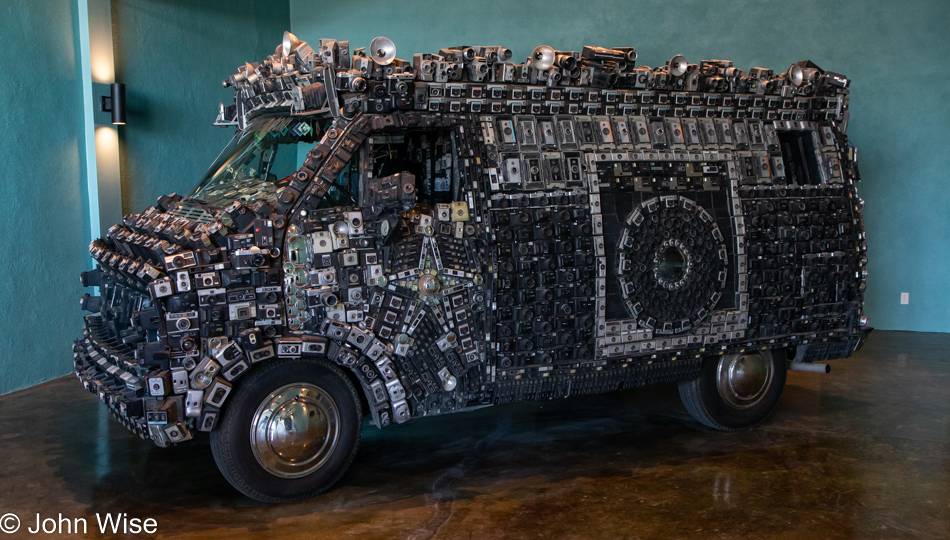
Both Harrod and Hunter come from a filmmaking background, though that would be too narrow a lens to focus on them. From our limited time here, it would seem that both are Rennaisance men who, from art, authorship, teaching, renovation, and even a bit of philosophy, are now trying their hands at revitalization as they tackle rebuilding a corner of a formerly prosperous mining town. Maybe the town and the timing are right to capture the need of people to get away and find experiences that are off the beaten path.
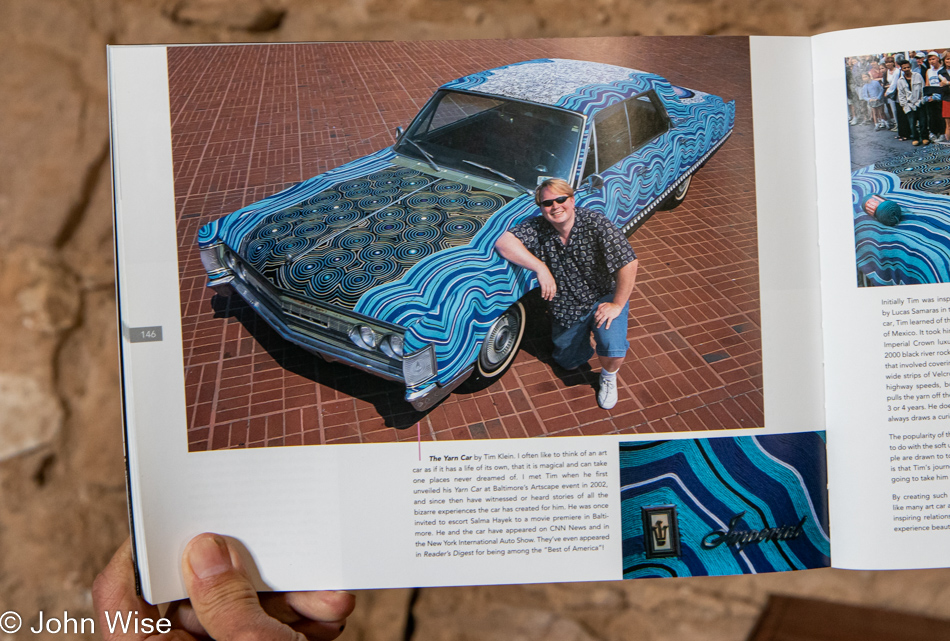
Caroline was responding to a decorative element on one of the cars, a wire sculpture of a woman at a spinning wheel, when Hunter grabbed a book by Harrod titled Art Cars: The Cars, the Artists, the Obsession, the Craft and opened to the pages that showcase the “Yarn Car.” We left with that book.
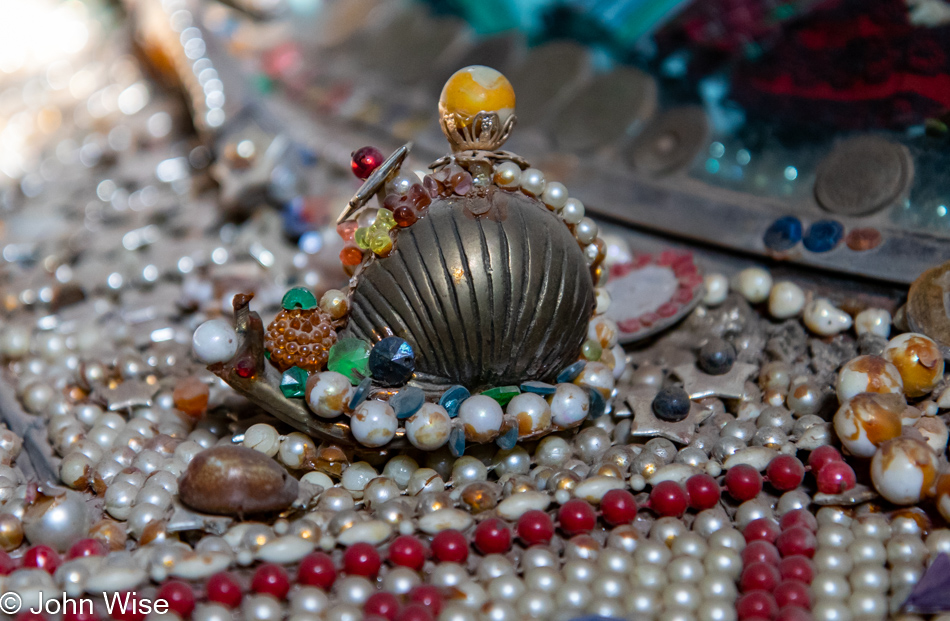
Behind the decorated snail is a windshield, and the snail itself rides on the hood of a car of a make, obscured by thousands of different pieces of jewelry, coins, and other things.
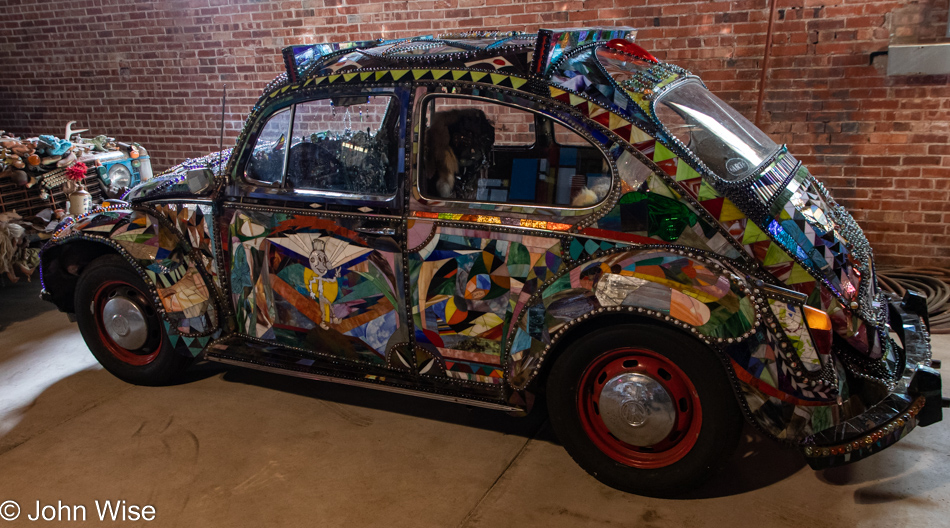
The facility in which these cars are being exhibited is a work in progress with a lot yet to be done, but the dust and construction yet to come are in no way detractors from the amazement the cars deliver to your senses. The wrought-iron transparent Beetle in the next room must be seen to be believed; the quote in the photo up above about “May you live as long as you want…” is from Harrod’s Oh My God Beetle, while this Beetle is fashioned with a layer of stained glass that has been painstakingly conformed to the shape of this iconic car.
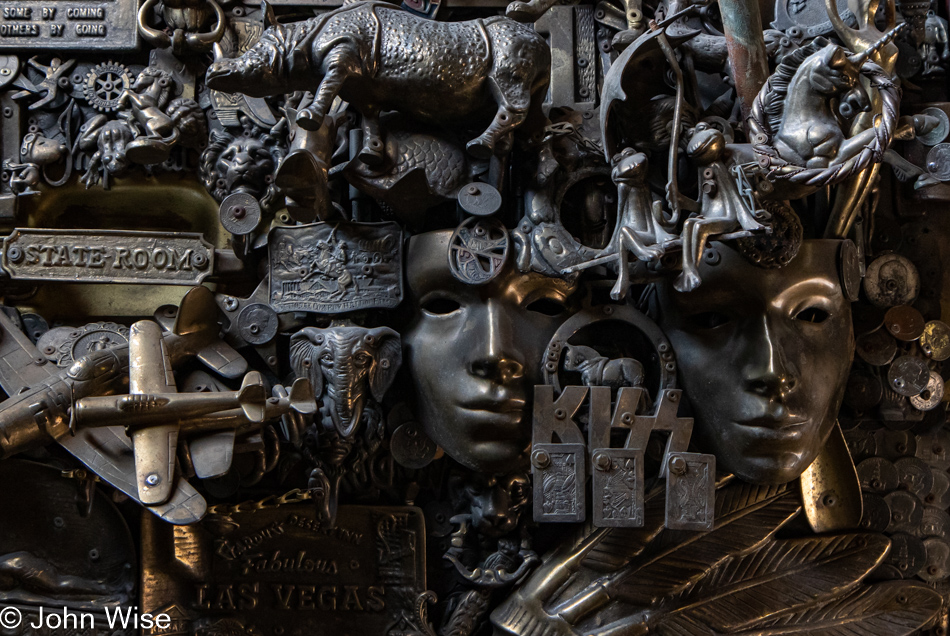
Close-up detail of the “California Fantasy Van” built by Ernie Steingold in Burbank, California. The underlying vehicle is a 1975 GMC van that originally weighed 4,700 pounds, with two tons of brass and thousands of dollars in coins; it now weighs 10,000 pounds.
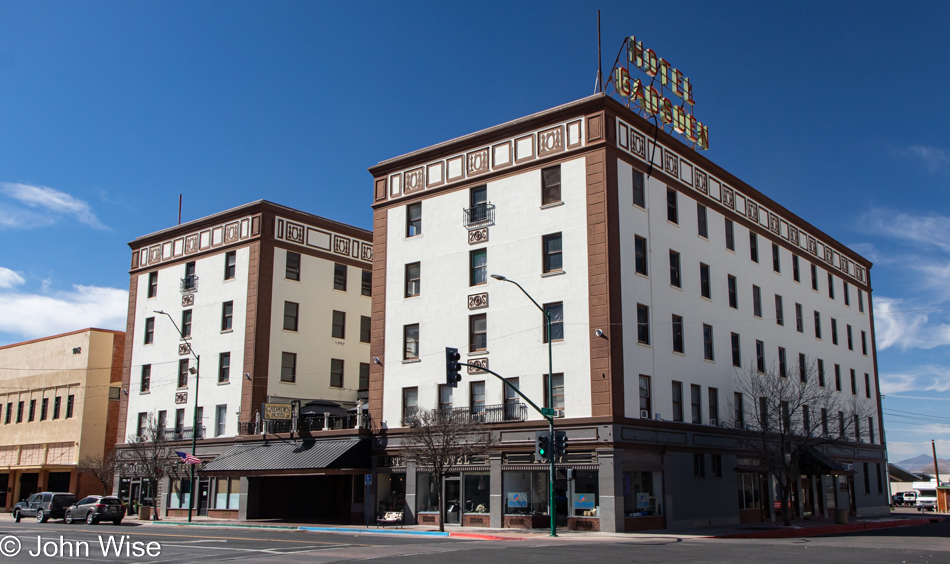
Awesome, got a decent photo of the exterior of the Gadsden Hotel. Caroline and I could easily see staying here again, although, with 21 more trips away from Phoenix scheduled for this year after completing the first four adventures, I don’t see us returning during 2022.
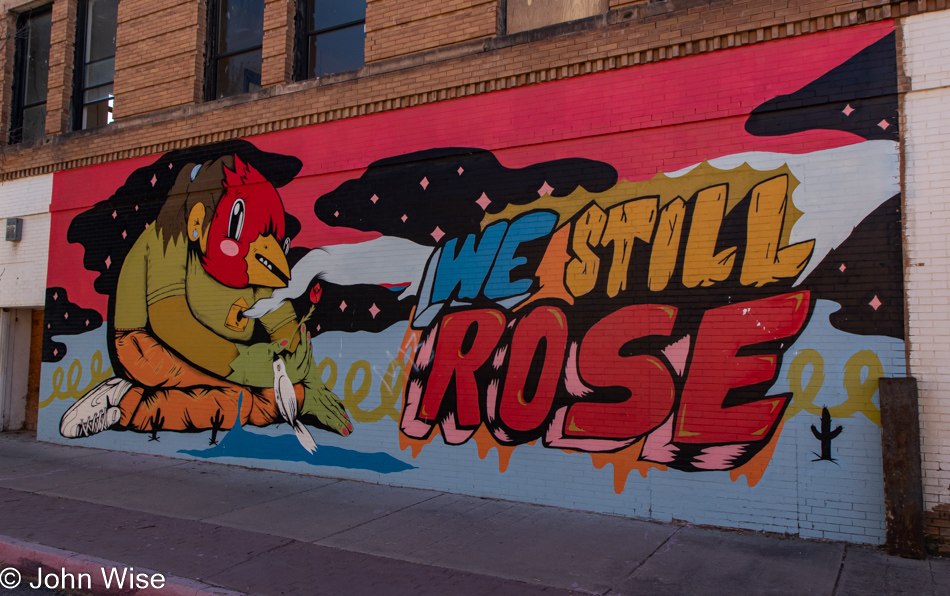
This weekend, we had the opportunity to meet entrepreneurs, students, and travelers, all making their contributions to this small desert outpost on the Mexican border. From Marina studying to be a firefighter, Cesar studying to be a nurse, Christian who understands he must move and grow to continue to improve his situation, to Cheryl who’s giving these young adults the opportunity that could allow them to reach their dreams. And then there’s Harrod and Hunter trying to inject culture and investment in the community; along the way are those of us down here looking for birds, rocks, and solitude, spending our dollars on lodging, food, gas, and souvenirs.
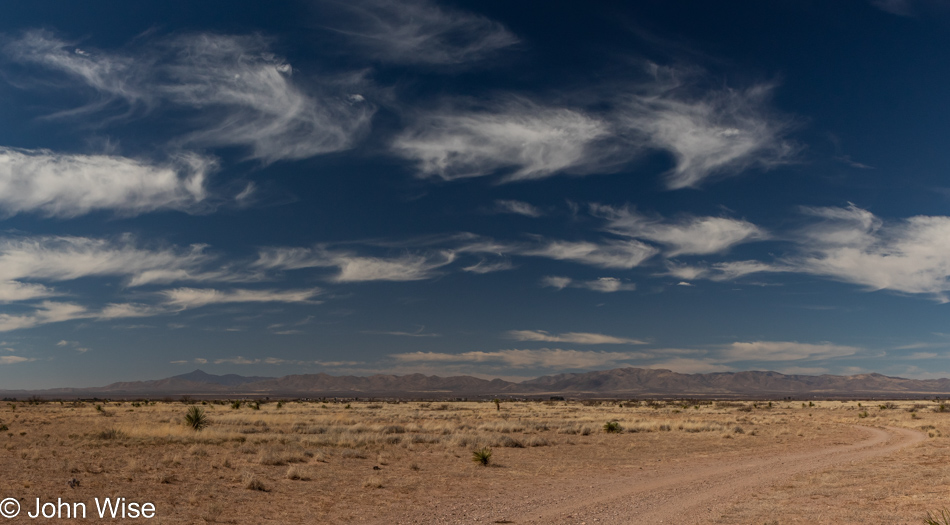
Sadly, I see a big, fat, ugly truth splayed out across this town and many small towns across America: if there isn’t a wealthy benefactor who picks up the slack of capital that is missing, these places are likely to continue to wither away. This equation suits the wealthy ruling class as it drags the undereducated out of these podunk towns and into the dead-end jobs required to make big cities go. In our rural decaying locales, there’s no justification for raising rents when houses go unsold and with jobs drying up as banks, grocery stores, and restaurants disappear, the opportunities of maintaining these places also go away. Unless the wealthy have decided that an old town holds promise to become an enclave for the rich, attrition will take it off the map. Such is the future of the populations that live out these ways, one of exploitation and servitude to debt traps.
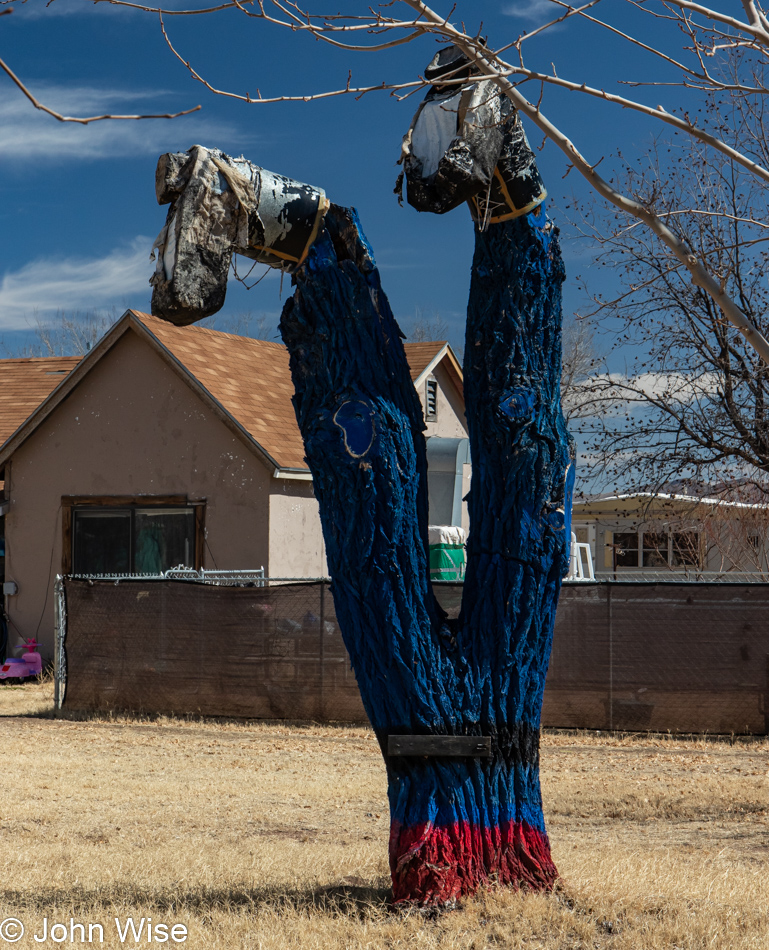
Maybe it is the knowledge of the cultural-economic warfare that has our rural population heavily armed and ready for combat, but little do they understand that money is simultaneously patient and frenetic. Money must move in order for capitalism to thrive, but the minuscule amount of cash represented by 50,000 households scraping by on the margin of anger doesn’t really represent a threat to those waiting for these curmudgeons to grow old and their children to move away. The ironic thing about this photo is that I’m reminded of the Nancy Sinatra song These Boots Are Made for Walkin’ except look at those feet; not only is the person’s head planted deep in the ground, but those feet are broken, ain’t nobody walking away from their economic trap out here and feeling good about it.
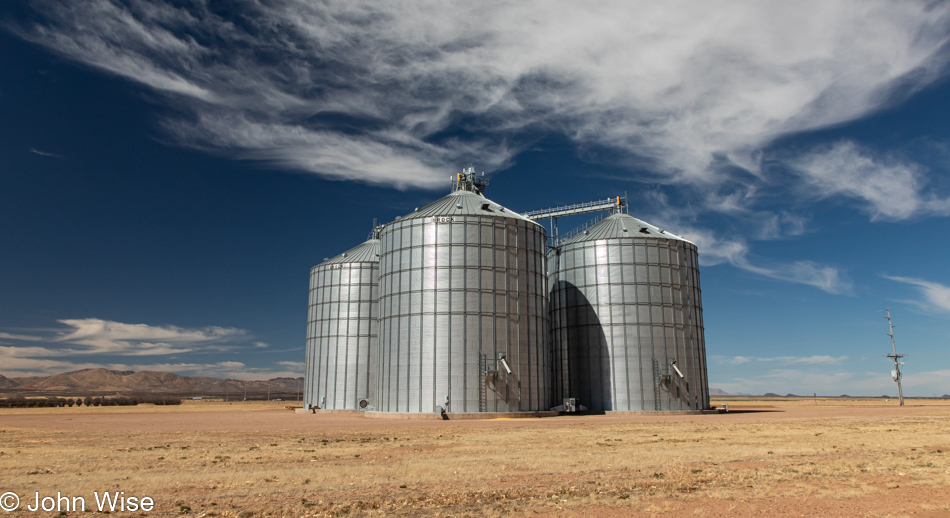
These silos are likely filled with beans at the expense of the limited amount of groundwater flowing underfoot. It’s a good thing that while Caroline and I are out here finding enchantment with the sights and sounds, I put the thoughts of reality behind me and enjoy the moment. I wouldn’t be able to argue against the idea that by returning home and dragging my perception of the ills of society into my travel narrative, I effectively shit on my own memories, but I’d also argue that I must remind myself of the anger I’ve felt that people of greater intellectual powers than me appear to be empty of the ideas that would have us acting equitably and operating with a forward-thinking plan that would capitalize on the will of those of us who if the infrastructure supported us, we’d work remotely in these areas and bring prosperity back to smalltown America. That’s enough of the social justice ax-grinding for another minute as I’ll try to finish writing about the rest of the day without equating dry lake beds with economic or racial disparities.
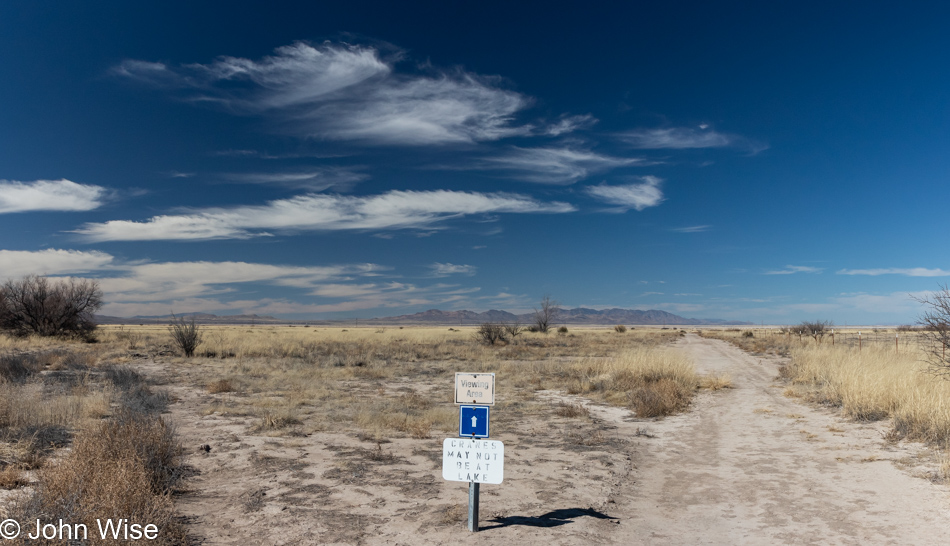
We were warned at the visitor’s sign-in station that the last people who walked out on Willcox Playa found not a drop of water nor a single crane. Maybe we should have heeded that, especially as the last entry in the visitor list was from earlier this very day, but we didn’t require birds and water; we were happy to be out for a nice walk to the playa for the sake of it.
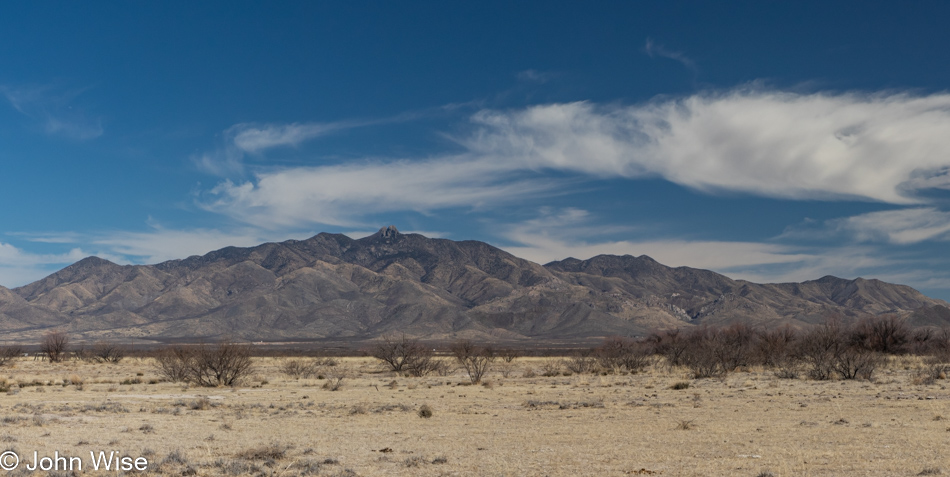
There are mountains nearly all around us, some still carrying snow, such as the Chiricahua Mountains to our southeast. These are not those mountains, as my photo of the snowcapped peaks was of poor quality.

It is obvious that there was once water here and maybe even recently. Nearby pumps suggest that people can turn this dry lakebed wet if they choose; I can only assume it’s not being pumped due to some level of depletion, with whatever remains being promised to the local bean and grape growers. Grape growers in the desert? Willcox has become well-known as a wine region because we are just that fucking stupid. Oops, I was getting off my soapbox, wasn’t I?
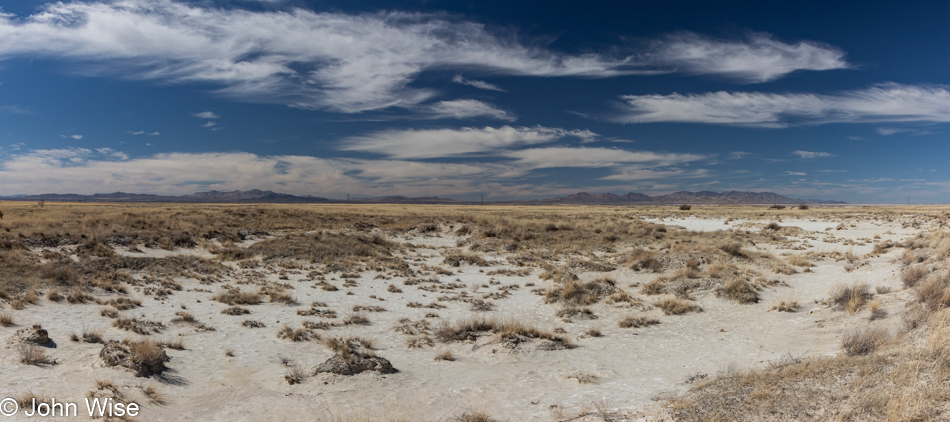
I love arid places where everything but scrub grass has ceased to exist. Without a sign of a bird, snake, lizard, javelina, or even an insect, I can rest assured that there are places to visit where I can celebrate the total annihilation of the environment that was exchanged for a bit of economic activity that arrives in air-conditioned homes in Phoenix, Scottsdale, Tucson, and Flagstaff that is as sweet as the blood that was drained from the lives we squeezed for our pleasure. Long live those kinds of incentives that make me proud to be (in)human.
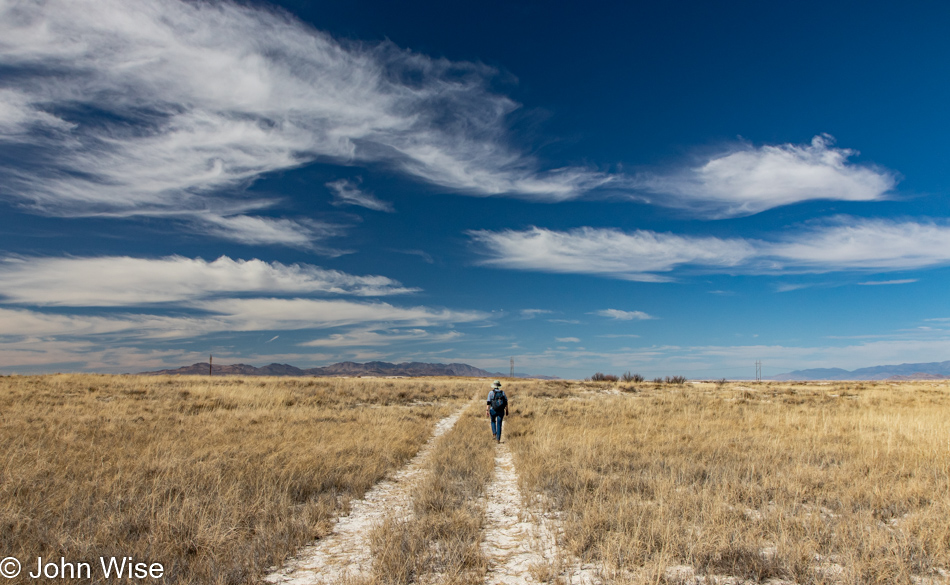
Keep on walking, Caroline; the vintner is just over the horizon chanting his mantra that your bodily fluids are his soylent-profit; we are likely next after the weeds fail to offer value.
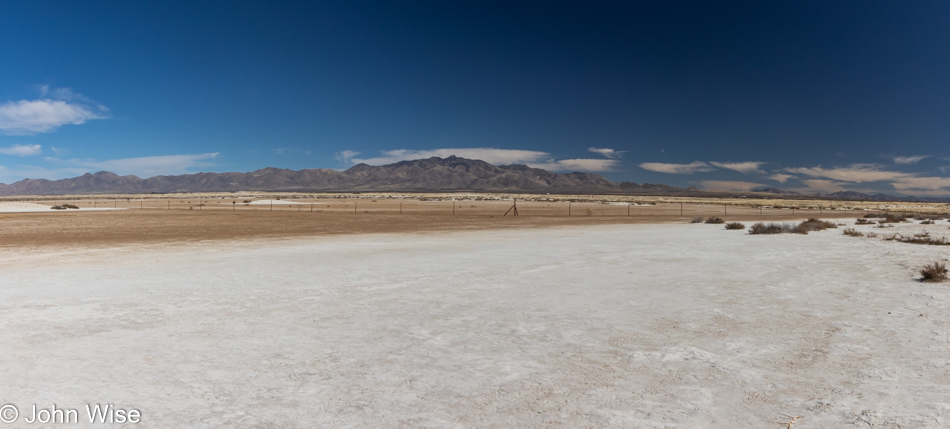
All snark aside, this playa is incredibly beautiful, and even without its blue reflective waters and the cacophony of thousands of migrating birds to fill the quiet, we couldn’t be happier to be out here right now, all by ourselves. Again, solitude makes an appearance, and we are the luckier to be on hand for it. Those are the Dos Cabezas Mountain in the distance, I think.
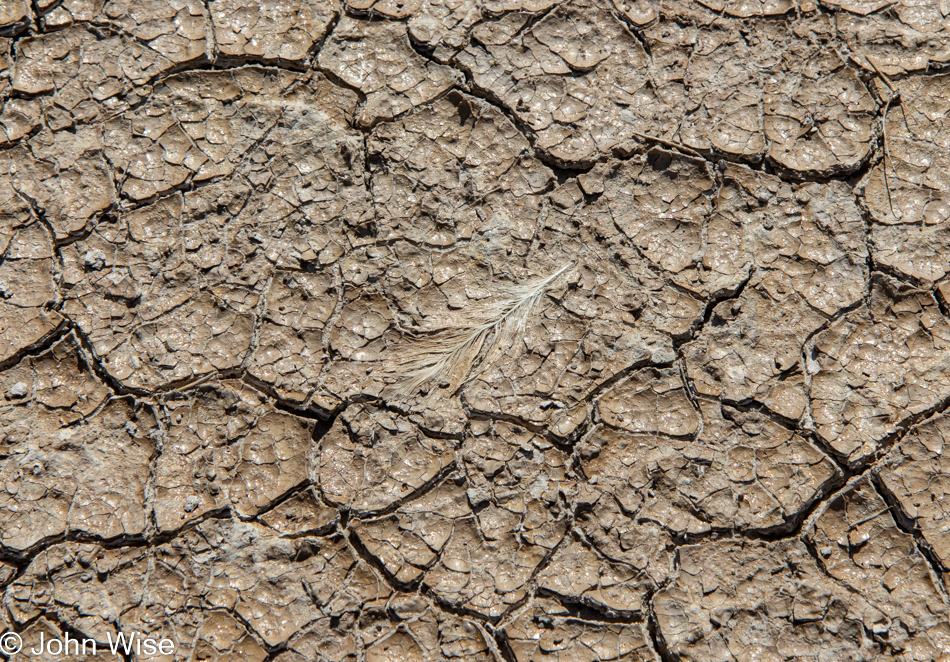
While difficult to see clearly in this photo, there’s a somewhat shiny patina of bronze crust overlaying the cracked mud, and while we don’t know what species of bird that feather came from, at least there’s evidence that at times they might be able to roost here.
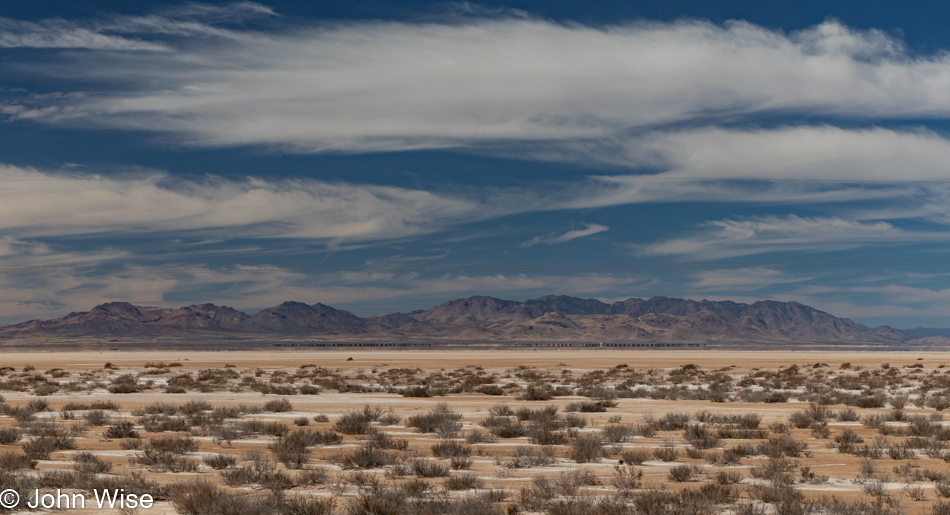
There’s a thin black line interrupted by a tan space at the foot of the mountains out on the horizon; it’s a string of train cars traveling west. Between them and us, and difficult to see, is a mirage that looks a lot closer to us than it likely is. To the best of my calculating ability, the train is about 8 miles from us.
A great article up at a Northern Arizona University website reads, “Willcox Playa is an interior-draining basin—the largest in the state. Such “graben” valley landforms developed in the Southwest over the past 20 million years as the earth’s crust has been tectonically pulled apart. This same tectonic extensional process is occurring in East Africa’s Great Rift Valley.” Visit their website HERE to read more.
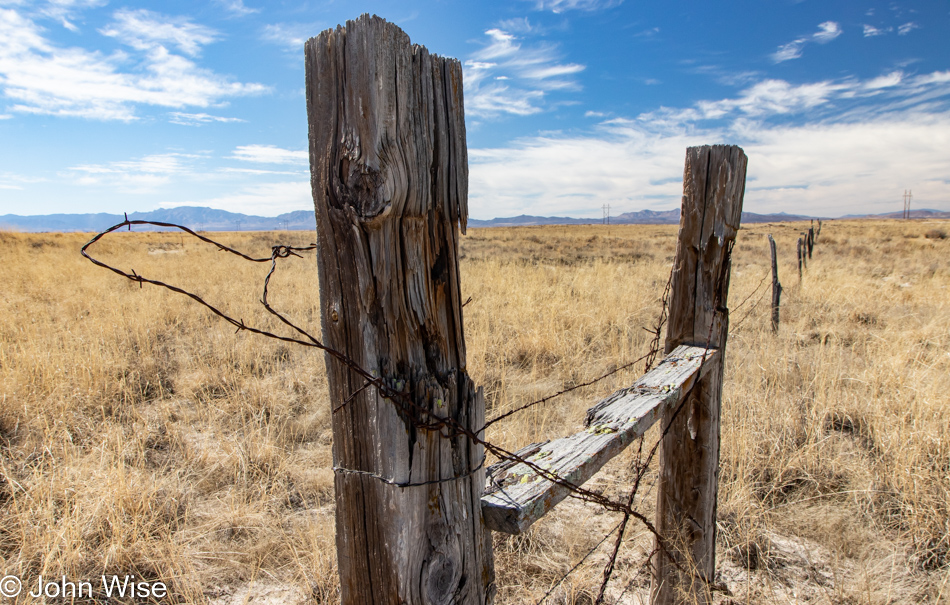
Signs of this being old ranch land and even relatively fresh cow patties where cattle have broken through the Arizona Game and Fish Department’s fencing are evidenced by images such as this.
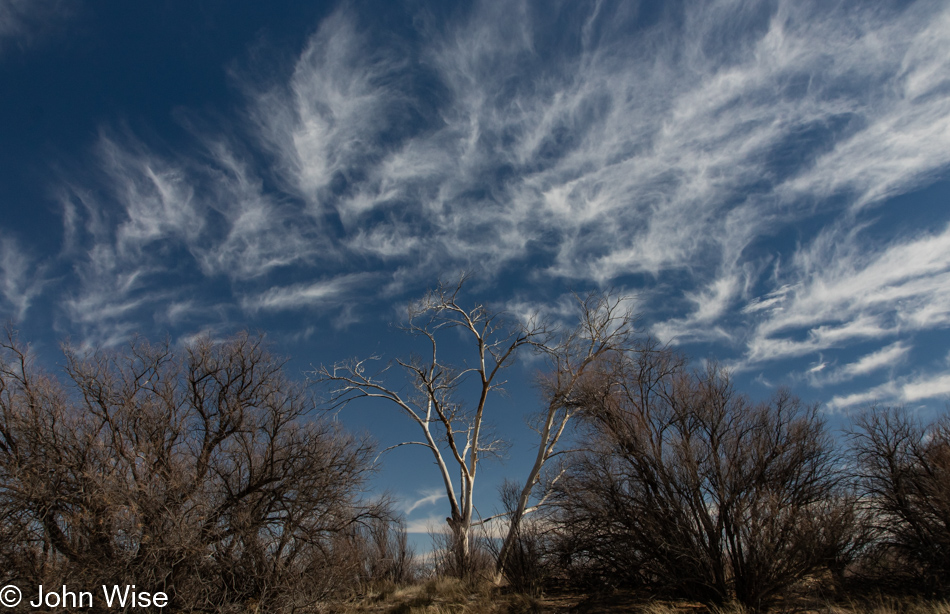
The winds across the region are picking up, and we are good and hungry, so a stop in Willcox at a local Mexican restaurant was next up on our impromptu itinerary. While it’s still relatively early in the day, we can see the need for a coffee, and just before reaching Interstate 10, a Safeway promises revitalizing cups of Starbucks being available within. We feel obliged for the safety of other drivers to imbibe on that caffeine; we sure wish we’d also grabbed a couple of donuts, but the voice of reason (Caroline) insisted we didn’t need them. Not four hours later, we were already back in Phoenix after another great weekend exploring things other than the habits found at home.